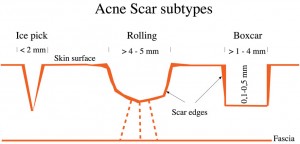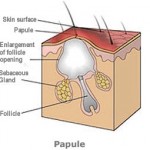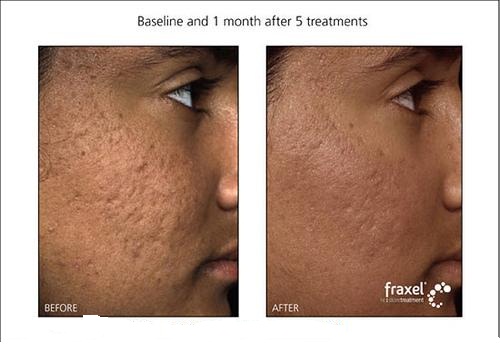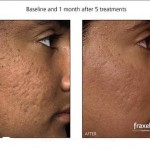Even with the most careful and conscientious treatment, acne scars may still occur. But not all scars are created equal. Generally, acne scars fall under two categories: those caused by a loss of tissue (atrophic), and those caused by an excess of tissue (hypertrophic). Within these categories, acne scars fall into one of four types: ice pick, boxcar, rolling and keloid scars.
Discolorations are not true scars but rather post-inflammatory hyperpigmentation, which will fade over time.
Ice Pick Scars
 Appearance: Ice pick scars are deep, very narrow scars that extend into the dermis. The skin looks as if it has been pierced by an ice pick or sharp instrument. Ice pick scars seem to make a small, deep “hole” in the skin. Some may look like a large, open pore.
Appearance: Ice pick scars are deep, very narrow scars that extend into the dermis. The skin looks as if it has been pierced by an ice pick or sharp instrument. Ice pick scars seem to make a small, deep “hole” in the skin. Some may look like a large, open pore.
Development: Ice pick scars develop after an infection from a cyst or other deep inflamed blemish works its way to the surface. Skin tissue is destroyed, leaving a long column-like scar.
Common treatments: Ice pick scars can be treated with punch excision or punch grafting.
Boxcar Scars
Appearance: Boxcar scars are round or oval depressions with steep vertical sides. Wider than ice picks, boxcar scars give the skin a pitted appearance.
Development: When an inflammatory breakout destroys collagen, tissue is lost. The skin over this area is left without support, and a depressed area is created. Boxcar scars may be superficial to severe, depending on the amount of tissue lost.
Common treatments: Treatments for boxcar scars include punch excision or elevation, dermal fillers, and laser resurfacing.
Rolling Scars
Appearance: This type of scarring causes rolling or “wave-like” undulations across otherwise normal appearing skin.
Deep Rolling Scar
Best treated by lifting the scar. Scars can be lifted most naturally with a procedure known as subcision. Another option is using a filler, such as Restylane® or silicone.
/ Wave-like appearance
Shallow Rolling Scar
These scars are not as depressed as deep rolling scars and can therefore be improved by lifting the scar with subcision or filler and can smoothed out with a Fraxelâ„¢ laser
/ Minor wave-like appearance
Development: Rolling scars arise when fibrous bands of tissue develop between the skin and the subcutaneous tissue below. These bands pull the epidermis, binding it to deeper structures of the skin. It is this pulling of the epidermis from within that creates the rolling appearance of the skin.
Common treatments: Rolling scars are best treated with subcision.
Hypertrophic or Keloid Scars
Appearance: A hypertrophic scar looks like a raised, firm mass of tissue. These types of scars often grow larger than the original wound. Hypertrophic scars caused by acne are most often found on the torso, especially in men.
Development: Unlike ice pick or boxcar scars, hypertrophic scars are not caused by a loss of tissue. Rather, they develop because of an overproduction of collagen.
Common treatments: Steroid (cortisone) creams, tapes, or injections are used to help shrink and flatten the scar. Interferon injections are also used to soften scar tissue.
Raised Papule
 Appearance: Small bumps. These raised scars are most common on the nose and chin and are usually treated by techniques which flatten them.
Appearance: Small bumps. These raised scars are most common on the nose and chin and are usually treated by techniques which flatten them.
Common treatments: Laser skin resurfacing with the Erbium:YAG laser is commonly used or radiofrequency ablation.
Deep Pit
Appearance: Sharp and deeply indented
Common treatments: Depending upon the width and depth, these scars can be treated with TCA Cross, Excision or Fraxelâ„¢ laser.
Shallow Pit
Appearance: Slightly sunken sharp edges
Common treatments: Best treated by Fraxelâ„¢ or TCA Cross
Enlarged Pore
Appearance: Also known as a superficial pit scar, Â appears as a tiny hole on the face
Development: This is a formerly clogged pore which was never healed. Enlarged pores can be found on the face, specifically on the central cheeks and around the mouth and nose.
Common treatments: best treated by the Fraxelâ„¢ laser.
How are Acne Scars different than other scars?
Acne scars are bound down and depressed. As with other scars, acne scars are the result of a wound in our skin healing, resulting in too much collagen in that particular spot. Unlike other scars, however, acne scars are bound down and depressed within our skin. Since the wound occurs within the dermis from the original inflammation brought on by acne, the scar is often within our skin, rather than on its surface. This makes acne scarring very difficult to improve.
Modern science has, however, developed some highly effective technologies for treating and removing acne scars. Lasers can be very effective at improving the look and texture of acne scarring.

